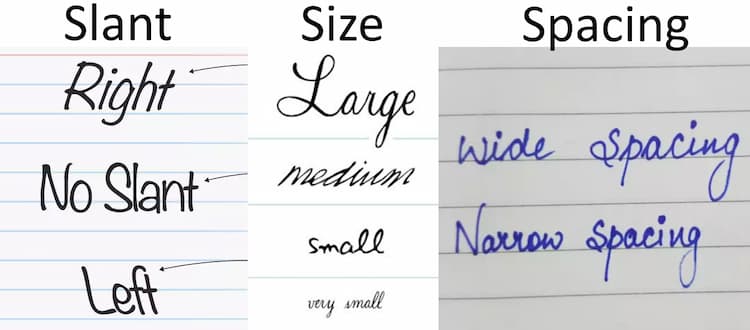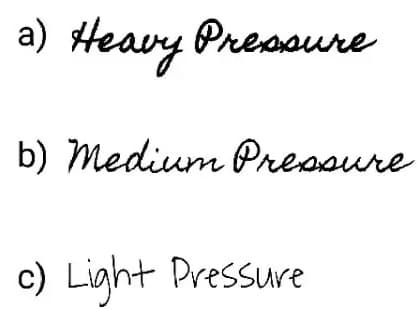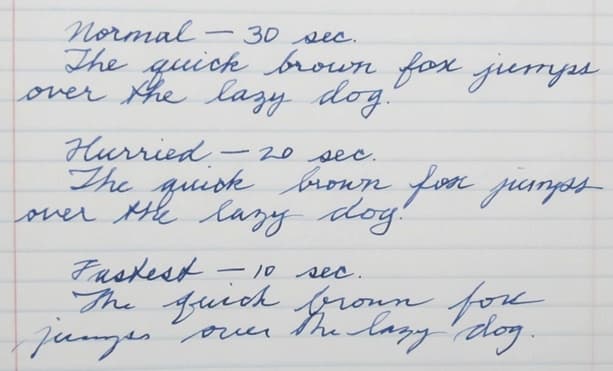
24 January, 2024
Psychology of Handwriting: What Does Your Penmanship Say About You?
Nowadays, handwriting might seem like an almost obsolete skill. However, the act of putting pen to paper remains an intimate and revealing form of self-expression. Graphology, or the study of handwriting, delves into the intricate nuances of individual handwriting styles to glean insights into a person's character, emotions, and even intellectual capabilities. While this discipline isn't universally accepted as a scientific method, it offers a fascinating window into the human psyche. This article explores the psychological elements that manifest in our handwriting and what they may reveal about us.
The Structure of Handwriting

1) Size
The size of one's handwriting is a fascinating focal point in the realm of graphology, and it tends to offer interesting insights into an individual's personality traits. By examining the size of the letters, experts in the field believe they can deduce certain behavioural tendencies, emotional states, and social inclinations.
- Larger Handwriting: People with larger handwriting are often perceived as outgoing and attention-seeking. This could indicate a desire for social interaction, a preference for being in the limelight, and a generally extroverted nature. It may also signify high levels of self-confidence, as these individuals are unafraid of taking up more physical space on a piece of paper, metaphorically reflecting their comfort with occupying 'social space.'
However, it's crucial to recognise that the context matters. For example, a person might display larger handwriting when they are feeling elated or excited. Emotionally, larger handwriting can sometimes be a manifestation of an enthusiastic or exuberant disposition.
- Smaller Handwriting: Conversely, smaller handwriting often correlates with introverted or focused individuals. These people may prefer solitude or small, intimate social settings rather than large gatherings. Their tendency to write smaller letters could reflect a more reserved nature and perhaps a reluctance to draw undue attention to themselves.
Smaller handwriting may also indicate a proclivity for concentration and attention to detail. This characteristic might translate into a meticulous approach to tasks and projects in academic or professional settings. Such individuals could be good at working on intricate problems that require significant focus and patience.
It's also worth considering the situational elements that may cause someone to write in smaller letters. For instance, emotional states like anxiety or self-consciousness could temporarily result in smaller handwriting.
- Middle-Size Handwriting: Not everyone's handwriting fits neatly into the categories of 'large' or 'small.' Many people have handwriting that is moderate in size, which may suggest a balanced personality. Such individuals could be socially adaptable, comfortable in both group settings and solitary scenarios, and capable of focusing on details while still seeing the 'bigger picture.'
2) Spacing
Believe it or not, the amount of space you leave can provide astute observations about how you interact with the world and the people around you.
- Narrow Spacing: Individuals who leave little space between words and letters might be seen as socially proactive or, in some instances, overly intrusive. This lack of spatial boundaries on paper could mirror their real-world interactions, where they might be more comfortable with close relationships and tighter social circles. These people often need to be involved and dislike being left out of any situation or conversation.
However, narrow spacing could also signify a person who, intentionally or otherwise, tends to crowd others, finding it challenging to respect personal boundaries. They might be the sort who get too close too quickly, either emotionally or physically, making some people uncomfortable. It could also indicate an impatient temperament, where the person is hurrying to get their thoughts down and, by extension, may be prone to making rash decisions.
- Wider Spacing: On the other end of the spectrum, wider spacing between words and letters may indicate an individual who values their personal space and independence. Such a person might lean towards introversion, cherishing solitude and preferring meaningful one-on-one interactions over large social gatherings. The roomy spacing on paper could metaphorically reflect their need for emotional and physical space in relationships.
Furthermore, wider spacing might suggest a tendency towards caution and deliberation. These individuals often think before speaking or acting and are less likely to intrude upon others' boundaries. They're also more inclined to carefully consider the pros and cons.
- Moderate Spacing: Many people fall somewhere between these two extremes, using moderate spacing in their handwriting. This could suggest a balanced approach to relationships and social interactions. They're neither overly intrusive nor overly distant, comfortable in solitary and social situations. Moderate spacing may indicate a well-rounded personality capable of adapting to different social dynamics.
3) Slant
The slant of one's handwriting, much like the spacing and size of letters, can be a treasure trove of information for graphologists. This feature can offer substantial insights into an individual's social tendencies, emotional state, and overall disposition. From extroverted to introverted, the angle at which you form your letters may be quietly telling a story about you.
- Rightward Slant: A noticeable rightward slant in handwriting is frequently linked to extroverted and emotionally open individuals. These people tend to be very accessible and willing to freely share their thoughts and feelings. A rightward slant often suggests a warm personality that seeks and enjoys social interactions.
Moreover, the inclination towards the right can imply an optimistic outlook. These individuals are often forward-thinking and proactive, both emotionally and practically. Their transparency makes them more likely to embrace new experiences with an open heart and forge strong, lasting relationships.
- Leftward Slant: Conversely, a leftward slant is often seen in people who are more introverted, reserved, or introspective. Unlike their right-slanting counterparts, these individuals may be guarded, keeping their emotions close to their chest. The leftward tilt could indicate a reluctance to readily engage in social situations, preferring a more cautious approach to interpersonal relationships.
Additionally, a leftward slant might signify analytical and logical qualities. These individuals often prefer to step back and assess situations before jumping in, and they may be more focused on the past and the lessons it offers for the present and future. It can also imply a degree of self-reliance; these people may not seek external validation as actively as someone with a rightward slant.
- Vertical Slant: Not everyone's writing fits neatly into the right or left slant categories. Some people have a vertical slant to their handwriting, suggesting a balanced or neutral emotional state. These individuals are often viewed as logical, disciplined, and more controlled in their emotional expressions. A vertical slant could indicate a person who tries to keep their feelings in check, neither too reserved nor overly open, striving for emotional equilibrium.
Signature Analysis
The way you sign your name is another interesting aspect examined in graphology. A legible signature often denotes confidence and a straightforward personality. In contrast, an illegible signature might suggest that the individual is difficult to understand or secretive.
1) Pressure

The pressure exerted while writing is an aspect often overlooked, but it holds significant psychological implications. According to graphology, the amount of pressure you apply on the paper can directly reflect your emotional intensity, assertiveness, and even energy levels. While not a foolproof method for understanding someone's personality, it certainly provides a fascinating layer to consider.
- Heavy Pressure: Heavy pressure applied to the paper during writing often correlates with strong emotions and heightened assertiveness. Individuals who write with heavy pressure are usually seen as emotionally and mentally intense. They tend to feel deeply and may not shy away from expressing their views or standing their ground.
This high-pressure writing style might also indicate a competitive nature and a desire for control. It could signify a person who is very engaged with their environment, keen to leave their mark (both figuratively and literally) on the world around them. However, on the flip side, heavy pressure may sometimes be linked to stress or even bouts of anger, revealing a heightened emotional state that could be less controlled.
- Light Pressure: On the opposite end of the spectrum, light pressure usually denotes sensitivity and possibly a lack of energy or lower emotional intensity. Individuals with this writing trait may be more introspective and less likely to assert themselves aggressively in social or professional situations. They might be more cautious with their emotional expenditure, choosing their battles wisely, so to speak.
Light pressure can also indicate flexibility and adaptability, as these individuals may find it easier to go with the flow, adapting to new circumstances without making a big fuss. But caution is advised in reading too much into this trait; light pressure could also be a sign of fatigue or temporary disengagement rather than a long-term personality characteristic.
- Moderate Pressure: Not everyone falls into the heavy or light categories; many individuals exert moderate pressure while writing, which could denote a balanced emotional state. Moderate pressure often suggests a level-headed, calm personality that neither internalises nor externalises emotions to the extreme. These people are often considered well-adjusted and may possess a blend of qualities associated with both heavy and light-pressure writing.
2) Speed

The speed at which one writes can offer a captivating insight into their personality and mindset. Whether scribbling quickly or meticulously crafting each letter, your writing speed can reveal much about your temperament, organisational skills, and even your approach to time management. While it's essential to interpret these traits with a grain of salt, they do provide a fascinating window into an individual's personality.
- Quick Writing: People who write quickly are often seen as impatient or highly organised individuals who place a premium on their time. The quick tempo of their penmanship may suggest a mind that's always racing, constantly juggling tasks and ideas. Quick writers are generally perceived as proactive; they are the doers who want to get things done and move on to the next challenge.
This rapid pace can also hint at a certain level of impatience. Quick writers may find waiting for others who can't keep up with their mental and physical tempo frustrating. They might have little tolerance for procrastination or indecision, as they are generally geared towards efficiency and productivity.
However, it's worth noting that quick writing could sometimes be attributed to hurriedness or even carelessness. These individuals might be prone to overlooking details in their haste to complete tasks, so while they value their time, the quality of their output might sometimes be compromised.
- Slow Writing: Conversely, slow writers tend to be introspective, cautious, and deliberate in their actions. They usually take the time to ponder their thoughts, making sure each word on paper is a faithful representation of their inner world. Slow writing can indicate a methodical approach to life, where each action is carefully considered, minimising the risk of errors or unintended consequences.
This cautiousness could extend to a person's social interactions, where they may take time to open up to others, carefully choosing whom to trust. Slow writers might also be deep thinkers, revelling in the nuances and complexities of issues others might overlook. They could be the type who thoroughly researches before making decisions or the ones who prefer quality over quantity in their work.
However, the downside to this deliberate pace might be a tendency towards procrastination or overthinking, leading to paralysis by analysis. In certain situations, the need to consider all options could slow down decision-making processes and impede progress.
- Moderate Writing Speed: Not everyone can be neatly categorised into quick or slow writers. Many people fall somewhere in between, displaying a moderate writing speed that suggests a balanced approach to life and work. These individuals may adjust their pace depending on the situation, switching between rapid note-taking during a meeting and slower, more thoughtful writing when penning a heartfelt letter, for example.
Special Characters and Embellishments
The quirks and flourishes in handwriting are intriguing markers of personality and emotion. These special characters and embellishments - loops, underlining, or how one crosses their 't's - can provide additional dimensions to the psychological profile sketched out by basic handwriting traits.
1) Loops: Loops in handwriting, particularly letters like 'y' and 'g,' can be portals to understanding the writer's emotional state and ambitions. Large loops might indicate a desire for attention or perhaps even a sense of feeling restricted or confined. The expansive loop could symbolise an expansive nature, a personality that wants to stand out, be acknowledged, or take up more interaction space.
Conversely, small or tightened loops may hint at a more reserved or introverted nature. The compact loops could suggest a reluctance to draw attention or an aversion to overextending oneself emotionally. The small loop might even point to an individual who feels comfortable within established boundaries and prefers not to deviate too much from the familiar.
2) Underlining: The act of underlining, especially regarding one's name, can be quite telling. Underlining one's name may be a sign of self-importance or confidence. The individual could be underlining their presence in the world, almost as if saying, "I am here, take notice." This flourish can indicate a level of assurance and belief in one's capabilities and impact.
However, frequent or exaggerated underlining might swing the pendulum towards arrogance or an inflated sense of self-worth. The act could reveal an underlying need for constant validation or a fear of being overlooked.
T-Bars: A Measure of Esteem and Aspiration
How one crosses their 't's or constructs their T-bars can reveal much about their levels of self-esteem and ambition. High T-bars often correlate with high levels of self-esteem and ambition. The higher placement suggests setting the bar high for oneself, reaching for goals and aspirations that match this elevated sense of self.
However, low T-bars could suggest a lack of confidence or feelings of inferiority. The low placement might indicate setting lower standards for oneself, perhaps due to self-doubt or previous experiences that have affected self-esteem.
Cautions and Criticisms
It's crucial to approach this form of analysis with a balanced perspective, acknowledging its limitations and criticisms.
1) Not an Exact Science: Handwriting analysis is not universally accepted as an exact science. While it has its roots in psychology and observational study, it lacks the empirical evidence often required to be considered a fully reliable scientific discipline. Consequently, it should be used cautiously and, ideally, in conjunction with other forms of psychological assessment.
2) Variable Factors: Mood, Age, and Physical Health: Handwriting is a fluid construct that can change based on many factors. One's mood at the time of writing can significantly alter handwriting characteristics. For example, someone upset or angry might exhibit heavier pressure and more irregular strokes compared to when they are calm.
Similarly, age can influence one's penmanship. An individual's handwriting may evolve over time due to changes in motor skills, experiences, or even changing attitudes and outlooks on life.
Physical health is another variable that can't be ignored. Conditions such as arthritis or tremors can affect the steadiness and form of one's handwriting, while factors like fatigue can lead to variations in pressure and size. These medical conditions could result in false readings when analysing handwriting traits.
3) Ethical Considerations: There are ethical concerns around using handwriting analysis for critical decisions, such as employment or legal judgements. Due to its subjective nature and the influence of various external factors, relying solely on handwriting analysis can be both unfair and inaccurate. Discrimination based on such an inexact method could lead to unjust outcomes, undermining the integrity of decision-making processes.
4) The Cultural Context: Cultural norms and educational systems also play a role in how one learns to write, affecting handwriting style. What might be considered 'normal' or 'neat' handwriting in one culture could be viewed differently in another. As a result, cultural bias can inadvertently influence the analysis, making it less universally applicable.
Conclusion
The psychology of handwriting remains a subject of intrigue and debate, providing both sceptics and believers ample room for exploration. While it may not offer definitive answers, your penmanship certainly tells a story, potentially revealing little-known facets of your personality and emotional makeup. Whether you see it as a form of art or a window into the soul, handwriting is undeniably a unique imprint we leave on the world.
So the next time you jot down a shopping list or write a heartfelt letter, you might pause to consider—what does your handwriting say about you?
The Printed Pens Team

